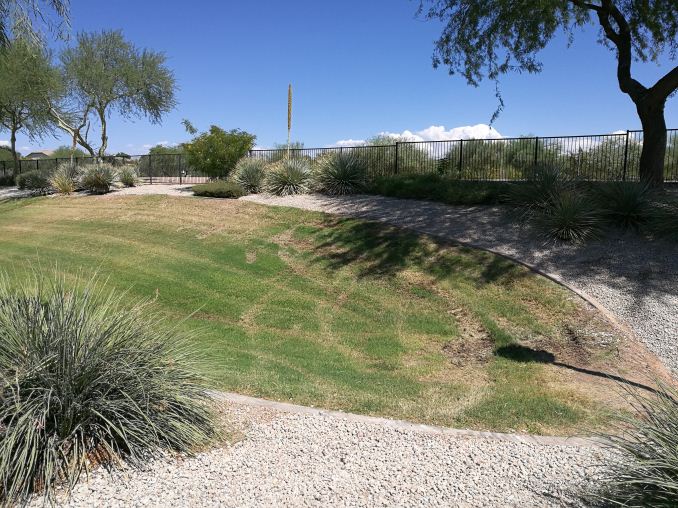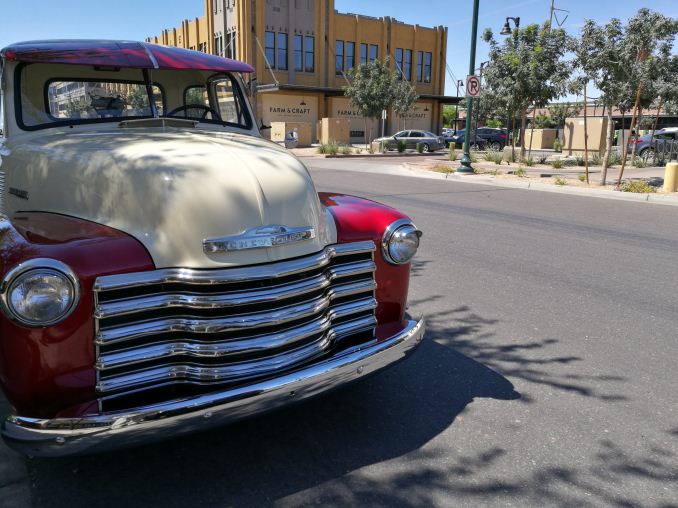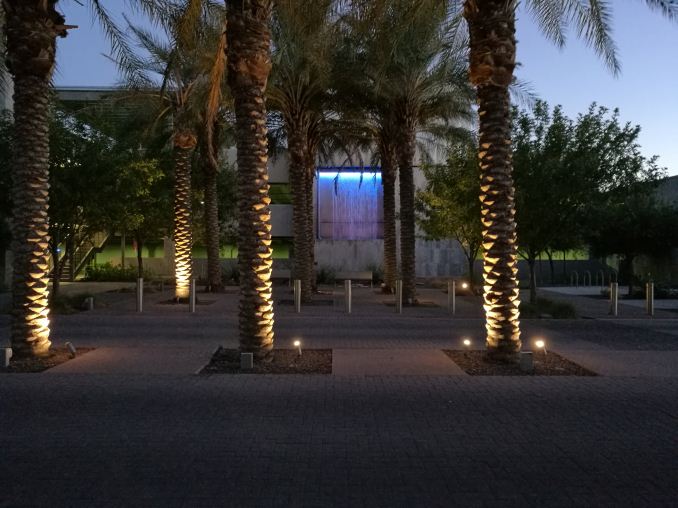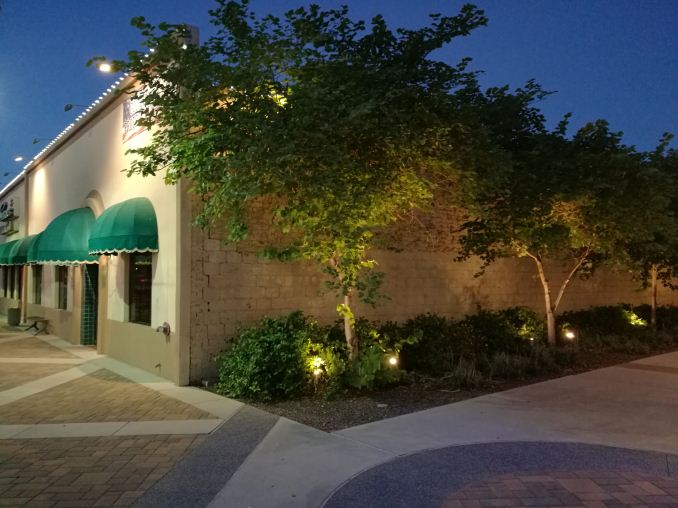The Huawei Honor 8 Review
by Matt Humrick on October 13, 2016 8:00 AM EST- Posted in
- Huawei
- Smartphones
- Mobile
- Kirin 950
- honor
Camera Still Image Quality
The Honor 8 is not the first phone with a dual camera nor will it be the last (it will not be long before it’s a standard feature), but it’s still fairly novel and interesting. To see what advantages (if any) it brings, I’ll be comparing its performance to several other cameras in a range of different settings. Unfortunately, the OnePlus 3 and HTC 10 are not available for testing, but the Samsung Galaxy S7 (12MP, f/1.7, OIS) will serve as a reference for high-end performance, while the Huawei Honor 5X (13MP, f/2.0) will serve as the lower bracket. The LG G5 (16MP, f/1.8, OIS) and Motorola Moto Z Play Droid (16MP, f/2.0) are also in the mix. The Huawei P9 uses the same sensor hardware as the Honor 8 but uses different software and Leica branded lenses, so it will be interesting to see if these add up to better photos. All of these phones capture images natively with a 4:3 aspect ratio except the 16:9 G5, and all of the images were taken using the stock camera app's Auto mode unless noted.
| Daylight Photo Comparison 1 |
In this first sunlit scene all of the cameras capture nice-looking photos, but there are some noticeable differences. The Honor 8 and Huawei P9 take a good exposure using the same ISO and shutter speed settings and avoid clipping the clouds like the Honor 5X and Moto Z Play. The Galaxy S7 is more conservative, slightly underexposing the scene.
The LG G5 captures the most accurate colors; it’s the only camera that does not oversaturate the blue sky. The Moto Z Play is a close second followed by the Honor 8 and P9, which give the sky a purplish tint. Both the Galaxy S7 and Honor 5X miss the proper white point: The Galaxy S7’s image has a slight green tint while the Honor 5X’s image is too cool.
Taking a closer look reveals that the Honor 5X’s image shows the most visible noise grain, although it’s still acceptable. The images from the G5 and S7 also show a bit more shot noise in the sky than the Honor 8, P9, and Moto Z Play. Comparing the Honor 8 and P9 shows a significant difference in noise reduction processing. The P9 does a little better job smoothing the sky, but it selectively applies more processing to darker areas in the image, smearing away detail from the bushes, grass, and rocks sitting in shadow while preserving detail in sunlit areas. The Honor 8 avoids this issue, and as a result I’d say the Honor 8 captures a better overall image than the P9 here.
| Daylight Photo Comparison 2 |
All of the phones except the Honor 8 and P9 overexpose this image and clip the highlights on the truck’s hood, with the Honor 5X going the furthest and clipping the sidewalk and sky too. It looks like the Honor 8 and P9 take a faster exposure to avoid clipping and then compensate by adjusting gamma higher to brighten the image. The result is a bright, nicely exposed image that’s lacking a bit of color saturation. Personally, I think the Honor 8 and P9 take the best images in this scene. Plus you can always increase color saturation with image editing software later, but you cannot recover the detail that’s lost in the clipped highlights from an incorrect exposure.
The Honor 8’s image also looks the best after zooming in. There’s very little noise with a high level of detail; the lettering on the building is clearly visible. The P9’s photo is similar but again we see it selectively apply more aggressive noise reduction on darker areas of the image, in this case wiping away detail from the road. Once again the Galaxy S7 and G5 show more noise grain than the Honor 8 and P9, but it’s a minor difference. The G5 somehow manages to show more noise than the S7 and still smear away more detail, particularly noticeable on the road. The Honor 5X’s photo has more visible noise grain everywhere and the Moto Z Play’s image shows some jpeg compressions artifacts around the lettering on the building.
The Honor 8, like the P9, does not offer an automatic HDR mode. Instead, it has to be enabled manually from a sub-menu, which is a bit inconvenient. The Honor 8 captures HDR images pretty quickly, roughly in 0.5 seconds, the same as regular photos, but this might just be the result of broken HDR processing. Looking at both sets of the Honor 8’s images above shows no difference between having HDR on or off, despite the camera app confirming the mode was turned on with a label on the screen. I tried taking many other HDR photos too, toggling the mode on and off, opening and closing the camera app, and even rebooting the phone, but I could not perceive any difference between photos with HDR on or off.
I encountered this problem with the P9 initially too, but at some point the issue resolved itself and HDR now works reliably. Even when it works, however, HDR has little effect on the P9’s images. It tends to brighten the entire image, rather than constrain itself to shadows, but only slightly. Huawei definitely needs to improve its HDR algorithm (and get it to work reliably) if it wants to compete with Samsung’s and LG’s cameras.
| Evening Photo Comparison 1 |
These photos were taken at sunset when there was still a little light left in the sky. While all of the cameras did well in sunlight, we start to see some obvious differences when there’s less light to work with. The Galaxy S7, LG G5, and Moto Z Play all expose for the foreground, creating brighter images but overexposing the sky. The G5 takes this to the extreme, automatically engaging its long exposure mode leading to an unnaturally bright image with a completely blown out sky. The Honor 8 and P9 opt for a more accurate exposure, creating darker but more realistic images. Determining which approach is better comes down to personal taste.
The Galaxy S7 and Honor 5X bracket the group in both price and performance, capturing the best and worst images, respectively. The Galaxy S7 sets the white point correctly and produces nicely saturated colors. It also keeps noise to a minimum and easily captures the most detail. The Honor 5X captures the darkest image but still overexposes the sky. It sets the white point too cool, has trouble focusing, and captures a noisy image.
The Honor 8, P9, and LG G5 all experience autofocus issues too. Even after taking several pictures with each, not a single one is properly focused. The Honor 8 sets the white point a little too cool, while the P9’s colors skew too yellow. The Moto Z Play’s image is not perfect, but color is good and both noise and detail are pretty good, giving it the edge over Huawei’s phones.
| Evening Photo Comparison 2 |
This group of pictures taken outside a restaurant after dark shows similar results. The Galaxy S7, LG G5, and Moto Z Play opt for longer exposures to brighten the scene, but overexpose the highlights on the building in the process. The Honor 8 and P9 avoid this issue, capturing more accurate, albeit darker images. The Honor 8 also experiences trouble focusing again; its best image is still a little blurry. The P9’s autofocus gets it right, capturing a sharp image with less visible noise grain and better detail than the Moto Z Play and Honor 5X. Neither the P9 nor Honor 8 can top the sharpness of the S7’s and G5’s images, however.
The Honor 8’s dual camera handles exposure very well across a range of conditions. Color saturation and accuracy is also pretty good, with only minor white point misses and a tendency to use darker shades of blue for the sky. In well-lit scenes, it keeps noise to a minimum and captures a lot of fine detail. Its autofocus system struggles in low light, but if you give it an assist by tapping to focus, it’s still capable of taking decent pictures. Although, it cannot match the performance of more expensive phones such as the Galaxy S7 and LG G5.
There is less difference between the Honor 8 and P9 than I expected. The images they produce are very similar, with nearly identical exposures and only very minor white point differences in low light. Noise reduction processing shows the biggest difference: The P9 selectively filters darker regions more aggressively, wiping away detail, which the Honor 8 avoids, tipping the image quality scale in its favor.
The only significant issue I found with the Honor 8’s rear camera is with HDR processing, or rather the lack thereof. I could not get HDR to work on my review unit. Even if it did work, the results would not be very impressive based on the P9’s HDR images. This is definitely a feature that needs improving.
Video Quality
The Honor 8 includes a number of nice video recording features that leverage the processing power of the Kirin 950 SoC and its dual-core ISP developed by Huawei. While the camera does not have OIS, there is an option for electronic image stabilization (EIS). The Honor 8 also includes optional object tracking autofocus similar to Samsung’s Galaxy phones. Tapping a moving object on the screen tells the camera to keep it in focus as it moves around. The feature works pretty well, but the camera can lose track of the object if it moves too fast or if there’s sudden changes in ambient light.
Another nice feature is the pro video mode that allows manual control over a few settings. It’s not as comprehensive as the pro photo mode, but it’s more than you get with most other phones. The pro mode allows you to adjust the metering mode, control focus manually, perform exposure compensation, and adjust the white balance, either by using one of several presets or adjusting it manually in 100K increments. The display shows a live preview of the changes, but adjustments cannot be made once it starts recording video.
| Huawei Honor 8: Rear Camera Video Modes | ||
| Video Mode | Video | Audio |
| FHD 1080p60 | 1920x1080, 34 Mb/s, H.264 C. Baseline | 192 Kb/s, 48 KHz AAC |
| FHD 1080p | 1920x1080, 17 Mb/s, H.264 C. Baseline | 192 Kb/s, 48 KHz AAC |
| HD 720p | 1280x720, 12 Mb/s, H.264 C. Baseline | 192 Kb/s, 48 KHz AAC |
| VGA 480p | 640x480, 5 Mb/s, H.264 C. Baseline | 97 Kb/s, 48 KHz AAC |
| QVGA 240p | 320x240, 1.2 Mb/s, H.264 C. Baseline | 97 Kb/s, 48 KHz AAC |
| MMS | 176x144, 195 Kb/s, H.264 C. Baseline | 97 Kb/s, 48 KHz AAC |
| Slo-mo | 1280x720, 120fps, 48 Mb/s, H.264 C. Baseline | 192 Kb/s, 48 KHz AAC |
| Huawei Honor 8: Front Camera Video Modes | ||
| Video Mode | Video | Audio |
| FHD 1080p | 1920x1080, 14 Mb/s, H.264 C. Baseline | 192 Kb/s, 48 KHz AAC |
| HD 720p | 1280x720, 12 Mb/s, H.264 C. Baseline | 192 Kb/s, 48 KHz AAC |
| VGA 480p | 640x480, 5 Mb/s, H.264 C. Baseline | 97 Kb/s, 48 KHz AAC |
| QVGA 240p | 320x240, 1.1 Mb/s, H.264 C. Baseline | 97 Kb/s, 48 KHz AAC |
| MMS | 176x144, 195 Kb/s, H.264 C. Baseline | 97 Kb/s, 48 KHz AAC |
It’s great to see a 1080p60 mode included, which is useful for filming action scenes because it greatly reduces the jerkiness that occurs with 30fps video. The downside is that the Honor 8 cannot use EIS or its object tracking autofocus when shooting 1080p60. Conspicuously absent is a 4K video recording mode, which has rapidly become a near standard feature on mid-range and flagship phones. When I asked Huawei why it does not include 4K recording with the Honor 8 and P9, it said that it does not see enough difference in quality to justify the increase in power consumption.
The Honor 8’s 720p120 slow-motion video is actually pretty good. The video looks darker and shows more noise than standard 720p video, but this is unavoidable due to the faster shutter speed required when shooting at 120fps versus 30fps. The video looks smooth and does not look like it’s being upsampled from a lower resolution. After shooting a video, it’s easy to adjust which segment of the video plays in slow motion, and exporting the video does not require any additional steps. As a bonus, the Honor 8 records audio with slow-motion video too, a rarity among Android phones. The audio sounds pretty good, but there’s a little too much reverb.
Overall video quality in its other modes is above average. Just like with still pictures, the Honor 8 consistently does well with exposure and white balance. Sometimes colors seem a bit undersaturated, possibly because it’s increasing gamma to brighten the video like it does with still photos, and the lack of HDR is certainly noticeable, although most phones still cannot do HDR video. When moving between light and dark areas, the Honor 8 does at least adjust the exposure quickly and smoothly to compensate as shown in the video sample above.
The Honor 8 uses the constrained baseline profile for all video modes instead of the high profile we prefer, and its bit rates are pretty typical for smartphones, resulting in some faint motion artifacts but nothing too severe. The Honor 8 is also slightly above average when it comes to video noise, ranging from very low with good detail in bright light to pretty grainy and soft in low light. Noise is also significantly more noticeable when recording 1080p60 video, including some yellow splotches mixed in with the random noise.
The Honor 8’s EIS works pretty well at eliminating small vibrations from shaky hands and also damping larger vibrations from walking. Obviously there’s a limit to what it can do, and it will create some jittery artifacts if there’s too much movement, but overall video looks better with it on then off. The autofocus system is also above average, continuously adjusting focus as needed, but occasionally getting hung up or adjusting more slowly when falling back to contrast AF. The Honor 8 is also pretty sensitive at picking up audio. I did not notice an issue with wind noise, but there was only a very slight breeze while I was recording.


























95 Comments
View All Comments
TheinsanegamerN - Thursday, October 13, 2016 - link
Why dont these companies use a T880-MP6 instead of a MP4? It never makes sense why they skimp on the GPU, but make a powerful CPU.mmrezaie - Thursday, October 13, 2016 - link
probably the same person who choses the glass on back of the phone makes that decision! One wonders...Lolimaster - Friday, October 14, 2016 - link
Put glass behind for more premium feel, --> everyone sees those nasty fingerprint grease, is that premium?zeeBomb - Sunday, October 16, 2016 - link
Yo I ship it!dsumanik - Monday, October 17, 2016 - link
Better than overpriced iShit, and you can still use headphones.utferris - Thursday, October 13, 2016 - link
These phones are usually sold to poorly educated people. And they are educated by the market that the more cpu core, the better phone. So people would usually prefer this SoC rather than Snapdragon 820, because Huawei has twice the CPU core number.You may think it is crazy, but it is the fact in the offline-market of China.
negusp - Thursday, October 13, 2016 - link
You seem poorly educated yourself; the Kirin 950 is, in most cases, faster then the 820, while being just or more efficient.lashek37 - Thursday, October 13, 2016 - link
The original Nokia is faster than this phoneoynaz - Friday, October 14, 2016 - link
Without a doubt. To be fair, the original Nokia was a rubber boot.Ethos Evoss - Wednesday, October 19, 2016 - link
which u won't buy .. another pathetic/naive child who talks about pointless performance and won't buy them.. what is even point you to comment ?!??